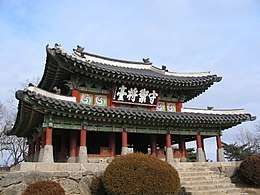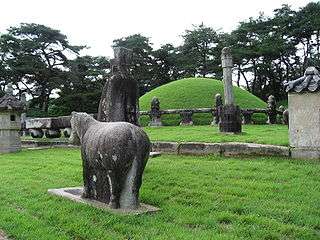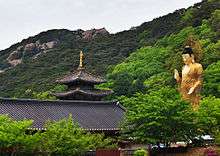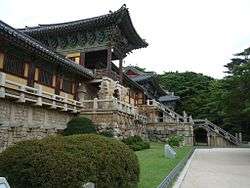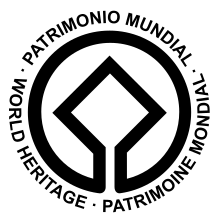List of World Heritage sites in South Korea
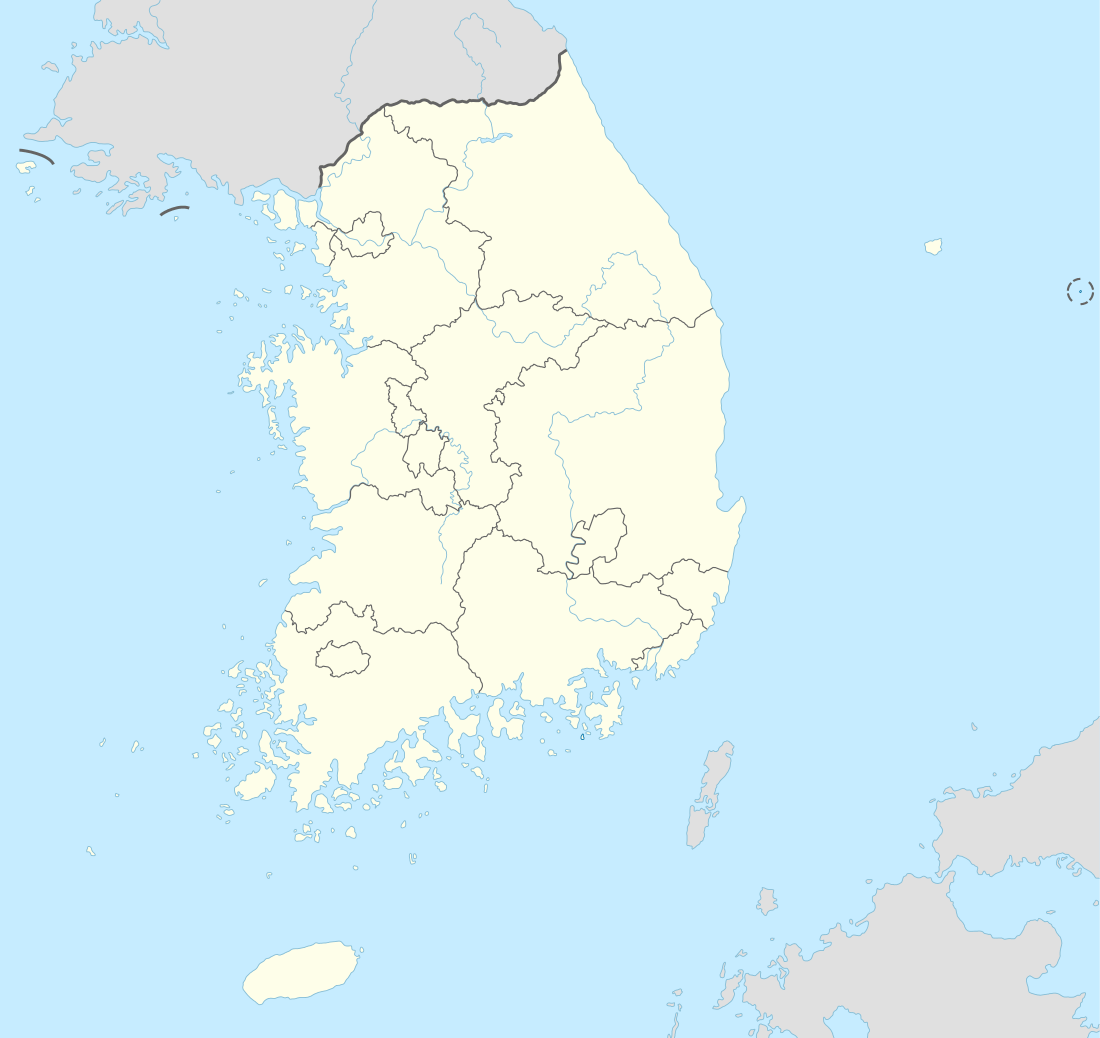
Note: Seoul is home to three separate properties; Royal Tombs of the Joseon Dynasty as well as Sansa locate throughout the country, only one site is shown on map respectively.
The United Nations Educational, Scientific and Cultural Organization (UNESCO) World Heritage sites are places of importance to cultural or natural heritage as described in the UNESCO World Heritage Convention, established in 1972.[2] The Republic of Korea accepted the convention on 14 September 1988, making its historical sites eligible for inclusion on the list. As of 2018, there are thirteen World Heritage sites in South Korea, including twelve cultural sites and one natural site.[1]
The first three sites of South Korea, Haeinsa Temple Janggyeong Panjeon, the Depositories for the Tripitaka Koreana Woodblocks, Jongmyo Shrine and Seokguram Grotto and Bulguksa Temple, were inscribed on the list at the 19th Session of the World Heritage Committee, held in Berlin, Germany in 1995.[3] In 2007, Jeju Volcanic Island and Lava Tubes became the first site selected for its natural significance.[4] South Korea's latest inscription, Sansa, Buddhist Mountain Monasteries in Korea, was added to the list in 2018.[5]
In addition to its inscribed sites, South Korea also maintains fifteen properties on its tentative list.[6]
World Heritage sites
The table is sortable by column by clicking on the ![]()
- Site; named after the World Heritage Committee's official designation[7]
- Location; at city, regional, or provincial level and geocoordinates
- Criteria; as defined by the World Heritage Committee[8]
- Area; in hectares and acres. If available, the size of the buffer zone has been noted as well. A lack of value implies that no data has been published by UNESCO
- Year; during which the site was inscribed to the World Heritage List
- Description; brief information about the site, including reasons for qualifying as an endangered site, if applicable
Tentative list
In addition to sites inscribed on the World Heritage list, member states can maintain a list of tentative sites that they may consider for nomination. Nominations for the World Heritage list are only accepted if the site was previously listed on the tentative list.[22] As of 2018, South Korea maintains fifteen properties on its tentative list:[6]
- Ancient Mountain Fortresses in Central Korea
- Daegokcheon Stream Petroglyphs
- Gaya Tumuli of Gimhae – Haman
- Kangjingun Kiln Sites
- Mt. Soraksan Nature Reserve
- Naganeupseong, Town Fortress and Village
- Oeam Village
- Salterns
- Seoul City Wall
- Seowon, Confucian Academies of Korea
- Sites of fossilized dinosaurs across the southern South Korean coast
- Southwestern Coast Tidal Flats
- Stone Buddhas and Pagodas at Hwasun Unjusa Temple
- The Goryeong Jisandong Daegaya Tumuli
- Upo Wetland
Seoul City Wall will undergo evaluation in the World Heritage Committee for 2017 designation.[23] Traditional Buddhist Mountain Temples of Korea were nominated by the Korean government as sole candidate from the nation for 2018 World Heritage Committee evaluation.[24][25]
Performance of South Korea in UNESCO
| UNESCO List | Exclusive Entries of the South Korea (Republic of Korea) | Shared/Multinational Entries Involving South Korea (Republic of Korea) |
|---|---|---|
| UNESCO World Network of Biosphere Reserves | 5 | — |
| UNESCO World Heritage List | 16 | — |
| UNESCO Memory of the World Register | 15 | 1 |
| UNESCO Global Geoparks Network | 2 | — |
| UNESCO Creative Cities Network | 8 | — |
| UNESCO Intangible Cultural Heritage Lists | 17 | 2 |
See also
| Wikivoyage has a travel guide for South Korea. |
References
- 1 2 "Republic of Korea". UNESCO. Retrieved 30 June 2018.
- ↑ "The World Heritage Convention". UNESCO. Retrieved 21 September 2010.
- ↑ "Report of the 19th Session of the Committee". UNESCO. Retrieved 10 August 2016.
- ↑ "Decision: 31 COM 8B.12". UNESCO. Retrieved 10 August 2016.
- ↑ "Four sites added to UNESCO's World Heritage List". UNESCO. Retrieved 30 June 2018.
- 1 2 "Tentative List – Republic of Korea". UNESCO. Retrieved 30 June 2018.
- ↑ "World Heritage List". UNESCO. Retrieved 28 May 2010.
- ↑ "The Criteria for Selection". UNESCO. Retrieved 10 September 2011.
- ↑ "Baekje Historic Areas". UNESCO. Retrieved 10 August 2016.
- ↑ "Gochang, Hwasun and Ganghwa Dolmen Sites". UNESCO. Retrieved 19 February 2017.
- ↑ "Changdeokgung Palace Complex". UNESCO. Retrieved 10 August 2016.
- ↑ "Gyeongju Historic Areas". UNESCO. Retrieved 10 August 2016.
- ↑ "Haeinsa Temple Janggyeong Panjeon, the Depositories for the Tripitaka Koreana Woodblocks". UNESCO. Retrieved 10 August 2016.
- ↑ "Historic Villages of Korea: Hahoe and Yangdong". UNESCO. Retrieved 10 August 2016.
- ↑ "Hwaseong Fortress". UNESCO. Retrieved 10 August 2016.
- ↑ "Jeju Volcanic Island and Lava Tubes". UNESCO. Retrieved 10 August 2016.
- ↑ "Jongmyo Shrine". UNESCO. Retrieved 10 August 2016.
- ↑ "Namhansanseong". UNESCO. Retrieved 10 August 2016.
- ↑ "Royal Tombs of the Joseon Dynasty". UNESCO. Retrieved 10 August 2016.
- ↑ "Sansa, Buddhist Mountain Monasteries in Korea". UNESCO. Retrieved 30 June 2018.
- ↑ "Seokguram Grotto and Bulguksa Temple". UNESCO. Retrieved 10 August 2016.
- ↑ "Tentative Lists". UNESCO. Retrieved 7 October 2010.
- ↑ . Chosun Media http://news.chosun.com/site/data/html_dir/2016/08/03/2016080300063.html. Retrieved 5 November 2016. Missing or empty
|title=(help) - ↑ . KBS http://news.naver.com/main/read.nhn?mode=LSD&mid=sec&oid=056&aid=0010271041&sid1=001. Retrieved 5 November 2016. Missing or empty
|title=(help) - ↑ . Chosun Media http://news.chosun.com/site/data/html_dir/2016/08/03/2016080300063.html. Retrieved 5 November 2016. Missing or empty
|title=(help)
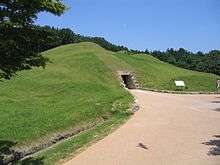
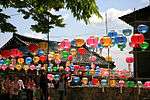
.jpg)
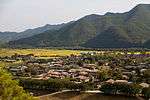
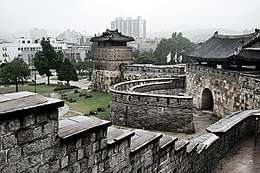
.jpg)
.jpg)
